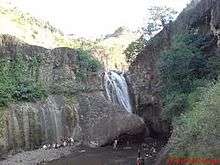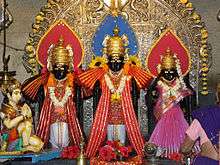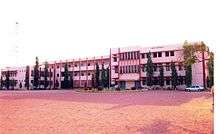Phaltan
| Phaltan फलटण | |
|---|---|
| Town | |
 Phaltan Location in Maharashtra, India | |
| Coordinates: 17°59′N 74°26′E / 17.98°N 74.43°ECoordinates: 17°59′N 74°26′E / 17.98°N 74.43°E | |
| Country |
|
| State | Maharashtra |
| District | Satara |
| Area | |
| • Total | 1,028 km2 (397 sq mi) |
| Elevation | 568 m (1,864 ft) |
| Population (2001) | |
| • Total | 50,798 |
| • Density | 49/km2 (130/sq mi) |
| Languages | |
| • Official | Marathi |
| Time zone | IST (UTC+5:30) |
| PIN | 415523 |
| Telephone code | 02166 |
| Sex ratio | Male 51% / female 49% ♂/♀ |
| agm | |
Phaltan (![]() pronunciation ) is a city, a taluka and a municipal council in Satara district in the Indian state of Maharashtra. The town is about 59 kilometres (37 mi) north-east of the city of Satara and about 110 km from Pune.
pronunciation ) is a city, a taluka and a municipal council in Satara district in the Indian state of Maharashtra. The town is about 59 kilometres (37 mi) north-east of the city of Satara and about 110 km from Pune.
History
Phaltan State was one of the non-salute Maratha princely states of British India, under the central division of the Bombay Presidency, under the states of the Kolhapur-Dekkan Residency, Satara Agency and later the Deccan States Agency. It was one of the Satara Jahagirs. The state measured 397 square miles (1,028 km²) in area. According to the 1901 census, the population showed a decrease of 31% in the decade at 45,739. The population of the town itself was 9,512 in that year. In 1901, the state enjoyed revenue estimated at £13,000- and paid a tribute to the British Raj of £640. Its flag was a rectangular bicolor, orange over green.
The Hindu ruling family was descended from Naik Nimbaji Nimbalkar (1284–1291), a Maratha who received a grant from a Mughal emperor in the 17th century. The ruler had the title of Raja, or Naik Nimbalkar. The first wife, SaiBai, of 17th century emperor Shivaji was from Phaltan. Major HH Raja Bahadur Shrimant Malojirao Mudhojirao Nanasaheb Naik Nimbalkar IV was the last Ruler of Phaltan.
Phaltan acceded to the Dominion of India on 8 March 1948 and is currently a part of Maharashtra state.[2]
List of Rulers
- Nimbraj I Nimbalkar, Naik 1284-1291
- Padakhala Jagdevrao Dharpatrao Nimbalkar, Naik 1291-1327
- Nimbraj II Nimbalkar, Naik 1327-1349
- Vanang Bhupal Nimbalkar, Naik 1349-1374
- Vanangpal Nimbalkar, Naik 1390-1394
- Vangoji I Nimbalkar, Naik 1394-1409
- Maloji I Nimbalkar, Naik 1409-1420
- Baji I Nimbalkar, Naik 1420-1445
- Powwarao Nimbalkar, Naik 1445-1470
- Baji II Nimbalkar, Naik 1470-1512
- Mudhoji I Nimbalkar, Naik 1512-1527
- Baji Dharrao Nimbalkar, Naik 1527-1560
- Maloji II Nimbalkar, Naik 1560-1570
- Vangoji II Jagpalrao Nimbalkar, Naik 1570-1630
- Mudhoji II Nimbalkar, Naik 1630-1644
- Bajaji I Nimbalkar, Naik 1644-1676
- Vangoji III Nimbalkar, Naik 1676-1693
- Janoji Nimbalkar, Naik 1693-1748
- Mudhojirao III Nimbalkar, Naik 1748-1765
- Sayajirao Nimbalkar, Naik 1765-1774
- Maloji III Rao Nimbalkar, Naik 1774-1777
- Janrao II Nimbalkar, Naik 1777-1827
- Bajaji II Rao Nimbalkar, Naik 1827-1841
- Mudhoji IV Rao Naik Nambalkar, Raja Shrimant, 1841-1916 (longest-reigning monarch in India)
- Maloji IV Rao Mudhojirao Naik Nimbalkar, Raja Bahadur Shrimant 1916-1948
Geography
Phaltan is located at 17°59′N 74°26′E / 17.98°N 74.43°E. It has an average elevation of 568 meters (1,863 feet).
Places of interest around Phaltan are: Vimantal (Airport); Goddess Maljai Mandir; Saibaba Mandir; Nimblak (which has been named after Naik-Nimbalkars as Nimblak) and Nimblak Naka, the oldest place in ancient Phaltan; Dhumalwadi (15 km or 9 mi from Phaltan, famous for waterfall)and Jabareshwar Mandir There are some forts around Phaltan, such as Wadgaum Nimbalkar, Santoshgad, Varugad, Mahimangad and Vardhangad. The fort Vardhangad can be reached from Satara also.
Phaltan's climate is an inland climate of Maharashtra. The temperature has a relatively high range between 15 to 45 °C (59 to 113 °F).[1] Summer in Phaltan is comparatively hot, and dry, compared to neighboring inland cities. Maximum temperatures exceed 40 °C (104 °F) every summer and typically range between 38–45 °C (100–113 °F). Lows during this season are around 25–28 °C (77–82 °F).
The city receives much less rainfall from June to September, and it has been declared as a drought-prone place by the Government. The city sometimes gets nil rainfall during the rainy season.
Winter starts in Phaltan from November to February. The winter temperatures are significantly higher compared to other cities in Maharashtra such as Pune and Nasik. Lows range from 14–16 °C (57–61 °F), while highs are in the range of 29–32 °C (84–90 °F). Humidity is low in this season, making weather much more pleasant.
Phaltan crosses a drought-prone area, and going towards the south and south-west of Phaltan, a dry area begins. Water supply to Phaltan for drinking and irrigation is done by water from Veer Dam on the Nira river. Nira Right Bank Canal (NRBC) flows through Phaltan, making it a partially green town.


Demographics
As of 2001 India census,[2] Phaltan had a population of 50,798. Males constituted 51% of the population and females 49%. Phaltan has an average literacy rate of 75%, higher than the national average of 59.5%: male literacy is 80%, and female literacy is 70%. In Phaltan, 12% of the population is under 6 years of age.
Culture
Phaltan is a very ancient city. The ancient name of Phaltan was Phalapattan (फलपट्टण ) . As per local mythology ,the origin of this name was taken from Saint Phalapattan Rishi . In litarary sources Ramayna , Phaltan was part of Dandakaranya., and Shree Ram , Laxman,Seeta was came here in Vanvaasa. It has a Temple of Shri Ram, who is said to be Gram daivat of the city. There is a Temple of lord shiva, which is called as Jabreshwar Mandir, this temple has beautiful stone carvings. Other temples in the city are Maljai Temple, Nageshwar temple, Sri Dnyaneshwar Mandir, Upalekar Maharaj Samadhi Mandir, Haribaba Samadhi mandir, Sai mandir in Jadhavwadi. There are many beautiful Jain temples in Phaltan. People of Mahanubhav panth identify Phaltan as South Kashi. The city has a mosque called Badshahi Masjid. A village named Rajale is home for an ancient temple of goddess Janai. Festivals like Diwali, Ganesh chaturthi, and Nagpanchami are celebrated here, mainly. In the month of November or December, the annual fair will be celebrated which is called as Shri Ram Rathostav. The idols of Lord Sri Ram and Sita made up of five metals (Panchdhatu) are placed in a decorated rath worshipped and is taken on a procession all over the city, this procession is called as Nagar pradakshina. The city is also an important center for Mahanubhav (Jaykrishni) Sampraday.
Places of Entertainment at Phaltan are: Namvaibhav Theater or Namvaibhav theatre is good running by multiplex City Pride Cinea Namvebhav Chitramandir. Rajvaibhav Theater (Rajvaibhav theaters is non operative as of now) and Indira Gandhi Sanskritik Bhavan (for art and cultural celebrations).
Places of shopping are: Sriram Bazar,City Bazar, local shops near Ambedkar chowk and Shankar market.

Industry
Phaltan Taluka has two Sugar Factories: New Phaltan Sugar Works Ltd., Sakharwadi[3] and Shri Ram Sahakari Sakhar Karkhana Pvt. Ltd., Phaltan.[4] Sakharwadi's sugar factory is the 2nd sugar factory of Maharashtra and moreover, the 1st private sugar factory in Maharashtra State.
Cummins India Ltd.[5] has its 300-acre 'mega-site' plant in Phaltan, which is being used to manufacture engines.
Transport
Most of the people prefer to use State Transport (Maharashtra Government) buses. Private vehicles, auto rickshaws can be used on rent basis. Traffic is quite chaotic, with no signals. Most of the people use two-wheelers or bicycles as a mode of transportation. The city has a nonfunctional airport, 2 km (1 mile) from the city. The airport has a facility to land 1 helicopter at a time. On the other hand, there is no flight landing facility. A few private buses also have daily service to Pune, Mumbai every night, with very affordable rates. There is no railway in Phaltan. The closest railway station is Lonand, 29 kilometres (18 mi) away. New highway construction has occurred from Phaltan to National Highway number 4.
Education
Schools and Colleges in Phaltan
- Phaltan Education Society College of Engineering, Phaltan
- Mudhoji High School and Junior College
- Mudhoji college
- MalojiRaje Agriculture College, Phaltan
- Shrimant Shivajiraje English Medium School (SSEMS)
- Borawake ITI college
- Kamla Nimbkar Bal Bhawan a school run by Pragat Shikshan Sanstha
- Yashwantrao Chavan College, Phaltan
- Rajiv Gandhi Polytechnic, Phaltan
- Sakharwadi Vidyalay
- Sardar vallabhbhai Patel high school, Sakharwadi
- Jaybhavamni high school, Tirakwadi
- Government D.Ed. college for girls
- Law college, Girvi Naka
- Brilliant Academy
- Industrial Training institute (ITI)
- Sahakar Maharshi Hanmantrao Pawar High School, Phaltan
- wunderbarkids, phaltan
- vishwajyot international school
- Shrimat Jayshreemaladevi Naik-Nimbalkar Institute of Management Studies, Phaltan
Phaltan is also the home of the Nimbkar Agricultural Research Institute(NARI), focusing on agriculture, renewable energy, animal husbandry and sustainable development. NARI's work on energy self-sufficient taluka (which became a national policy) was based on the extensive research on biomass availability in Phaltan Taluka.[6][7]


Notable residents
- Emperor Chatrapati Shivaji Maharaj's first wife Maharani Saibai was from Phaltan and belonged to the Nimbalkar dynasty.
- Nandini Nimbkar President of Nimbkar Agricultural Research Institute.
- Anil K. Rajvanshi Director of Nimbkar Agricultural Research Institute.
- B. V. Nimbkar, Padma_Shri winner and founder of Nimbkar Agricultural Research Institute
- Shivajirao Bhosale(deceased)
References
- ↑ Long term weather trends in western Maharashtra
- ↑ "Census of India 2001: Data from the 2001 Census, including cities, villages and towns (Provisional)". Census Commission of India. Archived from the original on 2004-06-16. Retrieved 2008-11-01.
- ↑ sakharwadi
- ↑ sugar
- ↑ cummins map
- ↑ Taluka's can provide critical mass for sustainable development of India
- ↑ Energy Self Sufficient Talukas - A solution to National Energy Crisis; EPW, Vol. 30, Issue No. 51, 23 Dec, 1995
External links
- List of rulers of Phaltan
- MSN Map The statue of sambhaji maharaj was established in survadi on the occasion of Sambhaji Maharaj jayanti on the year of 2013 by Dharmaveer Chatrapati Sambhaji raje group and grampanchayat survadi